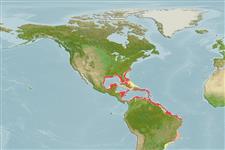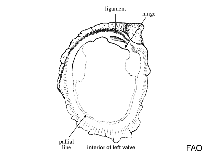Arcinella arcinella (Linnaeus, 1767)
Spiny jewelbox| Native range | All suitable habitat | Point map | Year 2050 |

|
| This map was computer-generated and has not yet been reviewed. |
| Arcinella arcinella AquaMaps Data sources: GBIF OBIS |
Upload your photos
Google image | No image available for this species;
drawing shows typical species in Chamidae.
Google image | No image available for this species;
drawing shows typical species in Chamidae.
Classification / Names Common names | Synonyms | CoL | ITIS | WoRMS
Bivalvia | Venerida | Chamidae
Environment: milieu / climate zone / depth range / distribution range Ecology
Benthic; depth range 2 - 73 m (Ref. 83435). Tropical
Distribution Countries | FAO areas | Ecosystems | Occurrences | Introductions
Western Atlantic: Caribbean Sea, from Florida to Brazil.
Length at first maturity / Size / Weight / Age
Maturity: Lm ? range ? - ? cm Max length : 5.3 cm DL male/unsexed; (Ref. 83435); common length : 5.1 cm SHL male/unsexed; (Ref. 360)
Short description Morphology
Shell: convex valves, slightly inequivalved and inequilateral; coloration is cream or delicately pink; sculpture consists of a score of radialribs decorated with spines whose breadth progressively increases from the umbo to the ventral margin of the valve; between the ribs are small granulations, irregularly arranged; lunule is very differentiated and heart-shaped; ligament is external, hinge is pachyodont; two large muscle scars (posterior is bigger than the anterior; dimyarian, anisomyarian), pallial line is continuous with no sinus. Body: foot is reduced to keep with its sedentary life; mantle cavity has a pair of gills, each with two series of lamellae, extensively fused by interlamellar junctions (eulamellibranch).
Life cycle and mating behavior Maturity | Reproduction | Spawning | Eggs | Fecundity | Larvae
Members of the class Bivalvia are mostly gonochoric, some are protandric hermaphrodites. Life cycle: Embryos develop into free-swimming trocophore larvae, succeeded by the bivalve veliger, resembling a miniature clam.
Main reference
References | Coordinator | Collaborators
Sabelli, B. and H.S. Feinberg (eds.). 1879. (Ref. 360)
IUCN Red List Status (Ref. 130435: Version 2024-1)
CITES status (Ref. 108899)
Not Evaluated
CMS (Ref. 116361)
Not Evaluated
Threat to humans
Human uses
| FishSource |
Tools
More information
Trophic Ecology
Food items
Diet
Food consumption
Ration
Predators
Diet
Food consumption
Ration
Predators
Ecology
Population dynamics
Growth
Age/Size
Length-weight
Length-length
Length-frequencies
Mass conversion
Recruitment
Abundance
Age/Size
Length-weight
Length-length
Length-frequencies
Mass conversion
Recruitment
Abundance
Life cycle
Distribution
Human Related
Aquaculture profile
Stamps, Coins Misc.
Stamps, Coins Misc.
Outreach
References
Internet sources
BHL | BOLD Systems | CISTI | DiscoverLife | FAO(Publication : search) | Fishipedia | GenBank (genome, nucleotide) | GloBI | Gomexsi | Google Books | Google Scholar | Google | PubMed | Tree of Life | Wikipedia (Go, Search) | Zoological Record
Estimates based on models
Preferred temperature
(Ref. 115969): 23.9 - 28, mean 26.7 (based on 214 cells).
Price category
(Ref. 80766):
Unknown.



